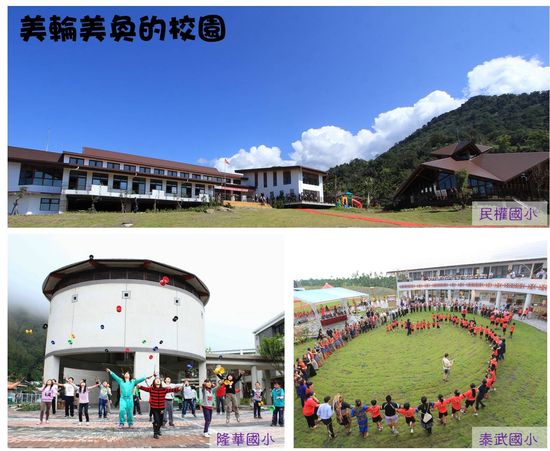


Morakot campuses redevelopment will be fully completed in November, 2013

In August 2009, Typhoon Morakot ravaged central and southern Taiwan and destroyed many school campuses, which used to be filled with joy and happiness. A total of 1,145 schools were damaged all over the country. Total damages were estimated around 1.5 billion NTD. 15 of the abovementioned schools sustained serious damages. To guarantee the schoolchildren’s right to education, the government implemented a program that enlisted college and university students to rebuild the campuses as a display of charity and focused on student placement. NGOs and enterprises were recruited to adopt schools in the reconstruction areas. 1,143 schools have already been rebuilt and the reconstruction of all campuses will be completed by late November 2013.
The rebuilt campuses are not only equipped with complete hardware facilities but also feature green building, solar energy, and wind power facilities as well as spiritual totems that incorporate local cultural features. For instance, Long Hua Elementary School in Nantou County features an image of an earth building with a dome roof, which symbolizes Hakka culture, while the wall at the main entrance to Da Bang Elementary School in Chiayi County is inscribed with the mythological story of the Great Flood of the Tsou Tribe. Indigenous sharp-nosed viper patterns and lily reliefs decorate the walls of the school buildings of Evergreen Lily Elementary School, while the roof of Taiwu Elementary School in Pingtung County is equipped with a solar panel and the walls at the entrance are inscribed with the story of the origins of the Paiwan Tribe. The walls of the school buildings of Langdao Elementary School in Taitung County feature the traditional “Boat Eye” pattern that is very important for the Yami Tribe. The library of Namasia Minquan Elementary School in Kaohsiung is built in the style of a traditional stilt house where male members of the Bunun and Southern Tsou Tribes congregate. Xiaolin Elementary School, on the other hand, passes on the culture of the Pingpu Tribe and Minzu Daai Elementary School offers multicultural education programs that are characterized by great diversity.
The principal of Taiwu Elementary School, Ms. Li-Hua Wu points out that “the school is grateful for the generous assistance provided by the government and the BenQ Foundation and the help provided by the construction aid team which enabled the school to complete the reconstruction of the campus within a period of only 2 years. Due to a deep identification with the Paiwan culture, features of the tribal culture have been ingeniously combined with green energy and technology to emphasize an equal focus on tribal traditions and international educational developments.”
The former principal of Minquan Elementary School, Mr. Ting-Yu Wu also states, “The cooperation between the government and NGOs made it possible to realize this project and the dream of closing the gap between city and country.”
The previous project manager of Delta Electronics Foundation, Ms. Ya-Yun Yang recalls, “the design process of Minquan Elementary School proceeded at a brisk pace. After soliciting local opinions and conducting numerous discussions it was decided to employ a “Net-Zero Energy” green campus design to rediscover the close relationship between humanity and nature.” The CEO of Chang Yung-Fa Foundation, Ms. De-Mei Zhong states, “construction aid for school campuses is only one small aspect of the charity work of the foundation. What’s more important is our constant supply of educational resources as well as continued acts of social concern to spread our love to every remote little corner of this island.”
The Reconstruction Council of the Executive Yuan points out that “the Post-Morakot Reconstruction work frequently has to focus on the construction of permanent housing at new sites after the relocation of villages (reconstruction at new sites). The construction of new campuses, on the other hand, is based on the principle of respect for local culture. After negotiations with tribal communities, tribal cultural elements are incorporated into the campus hardware and software facilities. This also represents a special characteristic of these campus-building projects. In addition, the Reconstruction Council has also convened 26 project meetings during the reconstruction process to establish a communication channel between local governments and NGOs and guarantee a smooth implementation of reconstruction programs. The Council is grateful to private groups and enterprises for their contributions to the reconstruction projects. The cooperation and joint efforts by private organizations and the government and altruistic acts for the benefit of society during the reconstruction process are a source of great pride for the whole country.”

Beautiful campuses

Adequate environment for education

Minquan elementary school in Namasia, Kaohiusng, designed with local indigenous culture

Jialan elementary school in Taitung equipped with green tech devices





